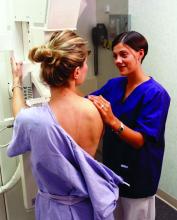More women received recommended mammograms after cost sharing for the service was eliminated under the Affordable Care Act, a study shows.
In health plans that eliminated cost sharing, such as copays, deductibles, or other out-of-pocket costs, the rate of biennial screening mammography increased from 60% in the 2-year period before the cost-sharing elimination to 65% in the 2-year period following the new regulation, according to an analysis in the New England Journal of Medicine.
Amal N. Trivedi, MD, of Brown University, Providence, R.I., and his colleagues conducted a difference-in-differences study of biennial screening mammography among 15,085 women aged 65-74 in 24 Medicare Advantage plans that eliminated cost sharing to provide full coverage for screening mammography. The investigators compared the results with 52,035 women in 48 matched control plans that had maintained full coverage during the same periods. Researchers gathered their study data from the Healthcare Effectiveness Data and Information Set (HEDIS) during 2007-2013 for Medicare Advantage plans and the Medicare Beneficiary Summary File. For socioeconomic data, investigators reviewed zip code information and 2010 census data. The study population included women aged 65 years and older who were eligible for the HEDIS quality measure for breast-cancer screening. The measure requires women to have been enrolled in the Medicare Advantage plan for 2 years with no gap in coverage exceeding 45 days. (Before 2012, the upper age limit for the HEDIS indicator was 69 years; from 2012 onward, the upper age limit was 74 years.)
In addition to the increased rate of mammograms in the first group, results showed the rates of biennial mammography in the second group were 73.1% (95% confidence interval, 69.2-77.0) and 72.8% (95% CI, 69.7-76.0) during the same periods, yielding a difference in differences of 5.7 percentage points. Investigators also found the difference in differences was 9.8 percentage points among women living in areas with the highest quartile of educational attainment, compared with 4.3 percentage points among women in the lowest quartile. After the elimination of cost sharing, the rate of biennial mammography rose by 6.5 percentage points for white women and 8.4 percentage points for black women, the study found. The rate was nearly unchanged for Hispanic women.
The findings extend that of past studies that show older women who need mammograms are sensitive to out-of-pocket costs and the presence of supplemental coverage, the authors conclude. If the cost-sharing provisions of the ACA are rescinded, the results also “raise concern that fewer older women will receive recommended breast-cancer screening.”
However, the authors also note that since mammogram rates in the health plans that eliminated cost sharing remained below those in plans with full coverage and less than three-quarters of women in control plans received biennial breast cancer screenings, that “the removal of out-of-pocket payments alone may not raise screening rates to desired levels.”
SOURCE: Trivedi A et al. N Engl J Med. 2018 Jan 18;378:262-9.

